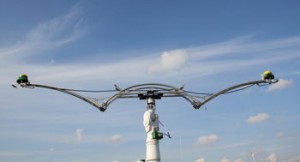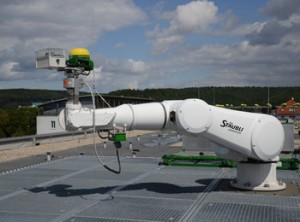A measuring robot outdoors
 A robot systematically goes about its business on the rooftop of the John Deere European Technology Innovation Centre – in summer and in winter, in rain, heat, cold or snow. A debilitating outdoor mission that only one robot manufacturer had the confidence to take on, namely Stäubli.
A robot systematically goes about its business on the rooftop of the John Deere European Technology Innovation Centre – in summer and in winter, in rain, heat, cold or snow. A debilitating outdoor mission that only one robot manufacturer had the confidence to take on, namely Stäubli.
Headquartered in the United States, John Deere is a global leader in the manufacture of machinery for agriculture, forestry and construction as well as for garden care. The company employs approximately 60,000 people in 68 factories and development centres around the world. Their ultra-modern European Technology Innovation Centre is in Kaiserslautern, Germany. Staff at ETIC collaborate with John Deere factories on developing innovative technologies and taking them through to the production stage where they are integrated into machinery. The focus is on “precision farming”.
Georg Kormann, Manager Advanced Engineering, leads a team that is working on the development of high-precision GPS receivers. What John Deere understands by “high-precision” goes far beyond the standards of the automotive industry, as Kormann explains: “With AutoTrac, we are currently able to steer farm equipment across the open fields with an accuracy of two centimeters. This works only with the special GPS receivers which we have developed in-house and which are all subject to the most stringent testing.”
The technical inspection of the receivers follows a complex procedure. The devices must undergo elaborate test runs in the open air at different speeds. In the past, the real-life test drives this required proved to be extremely costly and took many hours to complete. Furthermore, the comparability of the measured results from these field tests was partially impaired by deviations in the parameters.
And there was yet another problem that caused Georg Kormann a real headache: “Referencing the low-speed receivers calls for utmost precision, which must be higher than the accuracy of the devices themselves by a factor of ten. That means we need measurement techniques that are within the tolerance range of one millimeter. What could be better than to have the test runs performed by a precision robot, with the great advantage of reproducibility at any time?”
Outdoor robotics: A difficult concept to implement
A great idea, but its implementation in practice seemed almost impossible after taking a closer look at the feasibility. Problem number one was the planned outdoor use of the robot. In order to have full GPS reception, it was clear from the outset that the robot would have to be installed on the roof of the ETIC building where it would be exposed to the weather conditions prevailing in all four seasons.
 Dennis Dispot, who was charged with the implementation of the task as part of his university degree project at John Deere: “When we enquired of robot manufacturers if they could supply us with a six-axis all-weather model, we drew a blank except for Stäubli Robotics who were happy to rise to the challenge. The HE version of their fully enclosed six-axis Type TX200L should be able to cope with outdoor conditions, they told us. That sounded promising, and so we sat down together with Stäubli to work out the details of the project.”
Dennis Dispot, who was charged with the implementation of the task as part of his university degree project at John Deere: “When we enquired of robot manufacturers if they could supply us with a six-axis all-weather model, we drew a blank except for Stäubli Robotics who were happy to rise to the challenge. The HE version of their fully enclosed six-axis Type TX200L should be able to cope with outdoor conditions, they told us. That sounded promising, and so we sat down together with Stäubli to work out the details of the project.”
The six-axis models bearing the additional designation HE (= Humid Environment) have been specially modified for use in wet rooms. The fully encapsulated robot is designed to comply with protection class IP 65. Use of the Stäubli high-pressure unit takes this protection classification up a further notch – a useful option without which the outdoor deployment at John Deere would be far less likely to succeed.
Before the robots are given their final coat of paint, the surfaces undergo a special treatment designed to increase corrosion resistance and resilience. Parts that are particularly vulnerable to the elements are made __of stainless steel. The final coat of paint is of the highest quality to ensure that the robot can handle the toughest jobs. One other major plus point is the vertically aligned internal cabling. All connections are located under the robot base where they are protected from spray or, in the case of the John Deere machine, from rain and snow.
Gerald Vogt, who led development at the Stäubli robot main plant in Faverges, France before recently taking over the management of Stäubli Robotics in Bayreuth, Germany: “Quite frankly, when we brought the HE versions onto the market, we were focusing on operations involving waterjet cutting, the sort of machining that throws off a lot of swarf and the food industry with its intensive cleaning processes. We certainly weren’t thinking about year-round operations in the open air. But of course, the HE versions also offer optimum conditions for jobs like this one.”
Although the TX200L HE was genetically ideal for the project, there were still a number of outstanding issues: How was the robot to be hoisted onto the roof? What were the structural implications for the building itself? How were such matters as lightning protection, access control and security to be regulated? What additional modifications did the robot require? How was the problem of temperature fluctuation and condensation inside the robot arm to be dealt with?
Dennis Dispot: “Planning and implementation of the project took a long time, but we knew that we could always count on the support of Stäubli. With the expert assistance of the Stäubli engineers, we managed to find answers to all the technical questions. For almost two years now, the TX200L HE has been tracking its way around our roof and fulfilling its test marathon with exemplary aplomb under the toughest climatic conditions imaginable.”
Test facility of almost unlimited flexibility
What the John Deere staff especially appreciate is the virtually unlimited flexibility of this test system. The robot is able to simulate different travel cycles of tractors, including gradients and other parameters. Its 80kg bearing load makes the TX200L perfectly suited for comparative tests. The six-axis robot can carry multiple GPS receivers plus testing equipment simultaneously without coming up against any limits in terms of payload. More recently, the robot has taken on the job of testing sensor systems, and further tasks are being added by the day.
Particularly gratifying is the global use of the facility: all John Deere development centres around the world – including the USA, Asia and Europe – have access to the system and can use it to conduct their own tests. It is programmed offline on the user-friendly Stäubli Robotics Suite which is integrated into the higher-level software architecture. Collection and analysis of all data is fully automated. The measurement results obtained are then available to all John Deere sites around the world.
Georg Kormann is full of praise: “The setup has met all of our expectations with flying colors. Because of the ever-growing range of tasks and the worldwide demand for access to the robot, it is fully employed around the clock. The TX200L HE manages continuous operation out in the open with exemplary precision and reliability. There can surely be no better testimony to the quality of a robot.”
Visit the Stäubli Robotics website for more information.
See all stories for Stäubli Robotics















